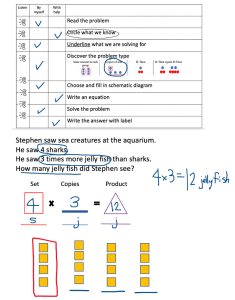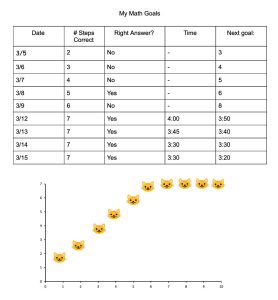Teaching Autistic Students to Solve Math Word Problems
August 29, 2022
In the past three months, how many times have you had no choice but to use cash to make a purchase? Or tell time using an analog clock?
Although you have undoubtedly made purchases, it is likely you used a card or smart device, especially if the purchases were made online. To check the time, you probably glanced at a digital clock on a screen or even just asked Alexa, Google Home, or another artificial intelligence device.
While the functions of many activities of daily living, such as making purchases and telling time, have remained the same over time, how we accomplish these tasks has changed dramatically as technology has evolved.
Math instruction for autistic students has historically had a limited focus on “functional” skills in order to prepare them for independence in their adult lives. Yet in addition to mastering a series of discrete skills, autistic young adults need to be able to problem solve. This includes:
Word problem solving is one way to teach students how, when, and why to apply math skills in real-world situations they will encounter in a future we may not be able to envision yet.
These research-supported strategies can help teachers and parents teach autistic students to solve word problems using modified schema-based instruction (MSBI). MSBI is an evidence-based practice for teaching word problem solving.
Word problems need to depict a realistic and meaningful problem. This will help students better understand the “why” behind word problem solving and support generalization to everyday situations. You can begin planning by identifying high-interest, real-world contexts when the targeted math skills could be used, such as familiar community locations, family routines, or preferred activities. The quantities represented in the problem should be realistic for the situation. Use technology to build background knowledge for generalization by showing short videos or pictures, such as videos of people making purchases using a credit card or comparing rideshare costs between two apps.
Both the materials and word problems themselves need to be accessible to students. The reading level, quantities represented, structure, and visual supports can all be adjusted to address barriers students may face. If independently reading the problem is a barrier, students can use technology to access text-to-speech or ask a skilled reader—a parent, peer, or teacher—to read it aloud to them. Quantities in the problem can be reduced to match a student’s numeracy skills (e.g., quantities under 10) or they can be provided with a calculator for efficiency.
Visual supports can be intentionally provided to support comprehension, such as icons above the two key nouns the problem is about. Providing an equation template like this can help prime them to remember each component of the equation that needs to be present: 
Research has shown that autistic students can successfully fade this equation template once they become fluent in problem solving.
Teaching word problem solving using MSBI may differ from your prior approaches to math instruction. Many teachers and parents teach operations sequentially, meaning once addition is mastered, they move on to subtraction, then multiplication, then division. But this developmental mindset can put unnecessary ceilings on student opportunity by having a “not ready for” mindset. Waiting for students to be “ready for” problem solving by overly focusing on their skill deficits will hold them back from meaningful, age-appropriate instruction.
MSBI also does not teach students to focus on keywords to identify operations, such as “more” meaning add and “left” meaning subtract. While this trick may initially work for some simple problems, it doesn’t help students conceptually understand the problem. Real-world problems won’t have keywords.
Instead of teaching by operation or focusing on keywords, research has shown when autistic students learn to identify and represent the problem by the schema (pattern of problem structure), they are able to independently solve, discriminate between, and generalize problems. There are two categories of schemas, or problem structures. Additive problems use addition and subtraction operations and include group/total, compare/difference, and change schemas. Multiplicative problems use multiplication and division and include equal group, multiplicative comparison, rate, and proportion. Here is a great resource that explains each schema.
The three key components of schema instruction are teaching:
MSBI provides additional support as needed for working memory, language, reading level, and numeracy skills so that students are engaged, motivated, and able to “show what they know” while problem solving.
Problem-solving routines draw students’ attention to the decisions they need to make and actions they need to engage in to arrive at a solution. General attack strategies can be effective. These are two examples:
UPS Check
DISC
Students usually write these at the top of their paper or reference them on a poster or whiteboard in the classroom. Autistic students and those with more extensive support needs will likely need a more detailed and personalized routine that breaks down the mathematical decisions into more discrete behaviors.
When developing routines to meet student needs, analyze the decisions that need to be made and behaviors involved in solving problems. Routines should always begin with reading the problem or requesting that a problem be read aloud. At least when students are initially learning the routine, they should have individual copies to follow, either printed directly on worksheets or as a separate visual support. Judiciously pair visual supports with text to give support but not so much that they are just relying on matching instead of demonstrating mathematical understanding. The general curriculum access lab at Florida State University has example problem-solving routines from research with students with autism and other developmental disabilities on their website.
You must explicitly teach students to follow a problem-solving routine. Use think-alouds with clear and concise language while actively engaging students in the problem-solving process. Opportunities for guided practice are important for identifying points of strength and areas of misconception. A system of least prompts (starting with the prompt that provides the least amount of assistance) can be used when students are not independently correct:
Self-monitoring and goal-setting can help facilitate independence in problem solving. Giving a space for students to check off steps as they are completed enables self-monitoring task completion to start as soon as they begin to solve the problem. The focus can shift to self-monitoring independence by having students check off steps completed “by myself” or “with help” as in the example below or self-monitoring duration by timing themselves.
 Students can then use this data to set goals, such as increasing steps completed by themselves or focusing on reducing duration of problem solving while maintaining accuracy. Research has shown autistic students enjoy this aspect of MSBI and have requested to add self-monitoring to other parts of their day, such as job sites.
Students can then use this data to set goals, such as increasing steps completed by themselves or focusing on reducing duration of problem solving while maintaining accuracy. Research has shown autistic students enjoy this aspect of MSBI and have requested to add self-monitoring to other parts of their day, such as job sites.

Word problem solving is an important skill for all students, as it puts math concepts and procedures into a real-world context. In addition, self-determination skills such as choice-making, self-monitoring, and goal-setting can be feasibly embedded to enhance effectiveness and efficiency. To prepare autistic students for independence in their futures, they need instruction focused on skills of the future, not the past.
 Jenny Root, PhD, BCBA, is an associate professor at Florida State University, affiliate faculty with the Florida Center for Reading Research, and a previous OAR applied research grantee. She has worked with autistic children and their families for about 15 years as a public school teacher, teacher educator, researcher, and consultant. Her research focuses on supporting meaningful academic skill development in school settings. She is especially interested in supporting teachers to apply the science of reading and science of math to students with autism and other developmental disabilities through research-practice partnerships.
Jenny Root, PhD, BCBA, is an associate professor at Florida State University, affiliate faculty with the Florida Center for Reading Research, and a previous OAR applied research grantee. She has worked with autistic children and their families for about 15 years as a public school teacher, teacher educator, researcher, and consultant. Her research focuses on supporting meaningful academic skill development in school settings. She is especially interested in supporting teachers to apply the science of reading and science of math to students with autism and other developmental disabilities through research-practice partnerships.